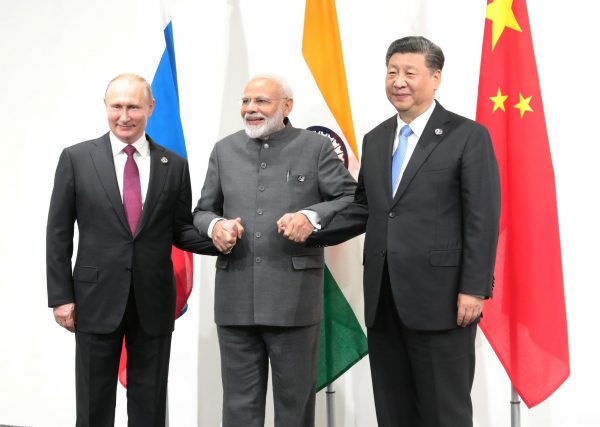From May 2014 to August 2017, Modi’s China policy focussed on constructing a balancing coalition with Australia, Japan, Vietnam and the United States, the most significant military powers in the Asia-Pacific (excluding South Korea). The objective was not to build an alliance, but rather to increase India’s diplomatic leverage with China. Doing this, Modi moved away from non-alignment and an insistence on following ASEAN’s lead in Asian security.
Simultaneously, Delhi sought to deepen economic relations with China — cooperating to launch the BRICS’s New Development Bank (NDB) and the Asia Infrastructure Investment Bank (AIIB), promising to develop two industrial parks for Chinese investors and pushing for a more equitable trade relationship. China’s invitation to join its Belt and Road Initiative (BRI), however, was snubbed. Delhi clearly worried that the BRI would expand China’s influence in Asia and that India’s membership would reduce its strategic autonomy.
By early 2018, however, India had changed course. Around the ‘informal summit’ with Chinese President Xi Jinping at Wuhan, Modi curbed Tibetan activity in India and boycotted the 60th anniversary celebrations of the Dalai Lama’s sojourn. The tone on the BRI also lightened. Then, in his Shangri La Dialogue speech, Modi insisted that the Indo-Pacific was not directed against China. What’s more, Delhi resumed its support of ASEAN ‘centrality’ in Asia’s security architecture.
Modi’s accommodationist posture continued despite no major gains for India in the economic relationship. The NDB delivered little, except that an Indian headed the bank. India was the largest grantee of AIIB loans, but at US$1.5 billion this was hardly game-changing. The two putative industrial parks struggled and the trade deficit with China ballooned to US$70 billion.
What, then, caused India to reverse tack from anti-China coalition building to a non-alignment twinned to ASEAN centrality?
By 2018, India was only a year away from general elections. In key state elections that year, the opposition Congress Party unexpectedly scored four victories. Modi faced a serious domestic challenge and, after the 2017 Doklam border standoff, could ill-afford another confrontation with China. Following the Doklam crisis, China expanded its military forces and works in the area. Any future confrontation was therefore unlikely to be resolved in India’s favour.
On another front, relations with the United States under President Donald Trump have deteriorated. Washington’s reduction of H-1B visas for Indians, the worsening trade war, insistence that India stop buying Iranian oil and a threat to curtail military cooperation if India purchased Russian S-400 missiles dashed hopes for a smooth partnership. Furthermore, Modi’s meeting with Trump at the East Asia Summit in Manila in 2017 went poorly. Elsewhere, Trump was caught on camera mocking Modi’s accent.
What should we expect from Modi’s China policy in his second term?
Domestically, Modi now stands supreme. India’s China policy could toughen as a result, but India’s economic challenges remain considerable and tensions with Beijing would be dangerous. Indeed, given the economic situation, including growing protectionism abroad, Delhi has a strong incentive to woo Chinese investors and consumers.
Militarily — although the border with China is quiet — the People’s Liberation Army is formidable. Another confrontation with China in which the Indian Army could be forced to back down would seriously damage Modi at home. Thus peace and stability along the border are vital.
With the United States, relations oscillate disconcertingly. Modi’s meeting with Trump at the 2019 G20 Summit in Osaka was cordial, but came after a series of belligerent presidential tweets on trade. Indo–US defence relations are burgeoning, but US officials continue to insist that purchase of the S-400s is unacceptable. India is part of the four-country Quadrilateral Security Dialogue, but it insists on differences with the US conception. Not surprisingly, Modi seemed happier in the company of other G20 leaders such as Xi Jinping, Shinzo Abe and Vladimir Putin.
Looking ahead, India’s post-Wuhan overtures toward China will likely continue. Differences over Pakistan and India’s Nuclear Suppliers Group membership will persist and Delhi will be watchful over Chinese influence in South Asia and the Indian Ocean. But India is likely to be pragmatic regarding the border, confidence building and economics. While India will stay away from the BRI, it will seek to engage China across other platforms. On global issues — such as climate change, protectionism and data localisation — it will partner with China, Russia and other developing countries.
Regionally, India will emphasise ASEAN ‘centrality’, downplay the Indo-Pacific, and stop advocating for freedom of navigation in the South China Sea. ASEAN and its partners are keen to sign the Regional Comprehensive Economic Partnership (RCEP) this year. India has stalled on RCEP, and Modi faces a tough decision on whether to risk even greater integration with China or to opt out of the deal. Given his election victory and economic challenges, and the desire to stand behind ASEAN centrality, the chances are Delhi will eventually sign.
A wild card that could disrupt this policy stance is another border incident or an incident at sea. Part of the new normal in India–China diplomacy since Doklam is to hold ‘informal summits’ where Modi and Xi engage much more directly on bilateral military problems. Wuhan was the first informal summit, and Xi is due to visit India for a second summit in late 2019. Military-to-military contact has increased since Wuhan, but both sides need to ensure that commanders and troops in the field are in sync with broader policy. Spokespersons on both sides have expressed confidence on this account.
In short, Modi’s China policy will probably look a lot like the prudential realism of earlier governments.
Kanti Bajpai is Director of the Centre on Asia and Globalisation and Wilmar Professor of Asian Studies at the National University of Singapore.


Very unfortunately true. Modi has inherited the weaknesses built into India’s Constitution and has continued to build on redistribution of wealth and social re-engineering rather than build a strong nation out of India. He is and intellectual moron rendered menopausal if not emasculate by adopting all the failed policies current since 1947.